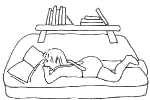by Hanna Vock
In their vocational training kindergarten teachers are taught to perform targeted observations and to document them. These observations of children's behaviour are useful for planning further steps and for team- and parent-consultations.
It has been my experience during our further trainings that kindergarten teachers will describe behaviour and the corresponding situation quite precisely and vividly. This skill is good basis for the recognition of giftedness. After all, kindergarten teachers with several years of professional experience have seen quite a few children of this age group, have got to know them and have observed them closely, which gives them a rather broad data-base by which to compare individual abilities and interests of a given child.
Focusing on the child's strong points is vital.
There is no quick answer to the question frequently asked at the very beginning of our courses: “How do I recognize a gifted child?”.
We must first consider this question: What is the point in wanting to recognize giftedness as early as at pre-school age? What is the aim?
Our Approach is to prioritize the recognition of the learning and playing needs and the needs for interaction which may differ quite substantially from those of children who are not gifted. Only after having understood these needs and the way they interrelate with giftedness can we support gifted children in accordance with their needs and developmental pace.
In our Certificate-Courses we make use of the Indicators of Possible Intellectual Giftedness and an additional observational checklist, which was developed by Joelle Huser in the course of an advancement project for gifted children in Zurich that also includes descriptions of characteristic behavior shown at pre-school-age. (Huser, 2000) Equally useful are lists by Urban (1992, D.161) and Roedell, Jackson & Robinson (2000, p. 63).
In order to come up with a comprehensive account of a child's talents and potentials the following items have proved meaningful:
-
A continuous practice of observation with the use of said checklists in different situations, especially such where the child is engaging in an activity of its own choice, if possible all throughout the entire time of attendance at kindergarten.
-
Evocative observation
(Types of Observation)
,
especially if the child is suspected of concealing abilities. (Concealing Abilities and Interests.)
-
Conferencing on observations with the team, especially if working in “open mode”, meaning groups are allowed to mingle throughout the day, activities may be attended by children from different groups.
- Consultations with parents about the interests and strong points of the child and about its (possibly rather different) conduct in kindergarten and at home. ( Questionnaires for Parents. )
Another desirable element would be the targeted observation of the child when participating in small-group-activities/ -projects which have been conceptualized with respect to the developmental stage of the child, so that they constitute a genuine challenge at the time. See: Domains of High Ability
At this point it is important to bear in mind that giftedness – and especially its exact degree – cannot be determined by observation only, but only through a formal test procedure.
Diagnosis With the Aim of Advancement . The authors of an advisory brochure (you can find it on the internet / see Bibliography ), which was published by the Bundesministerium für Bildung und Forschung (2000) [Federal Ministry of Education and Research], make that same point, they elaborate: Checklists may “however provide initial clues and heighten alertness with regard to the possibility that a given child might be gifted.” (S. 21)
However, in my opinion it must be said, that kindergarten teachers, who dispose of a profound understanding of the phenomenon giftedness and have over the years had plenty of experience with gifted children, are able to contribute assessments of a distinct quality not exhibited by formal tests. This is because kindergarten teachers observe the child's inclinations, actions, reactions and utterances in everyday situations presenting complex challenges met in social as well as one-on-one scenarios, and they make these observations over an extended period of time, often over the course of several years.
If the administration of a kindergarten is constituted to be conducive to the advancement of gifted children ( Characteristics of a kindergarten Conducive to the Promotion of Talent ) and an open atmosphere prevails throughout, and if the child has managed to establish a trusting relationship to the teacher, that teacher will learn a lot about the child's talents, things a formal test is not designed to detect.

For example: the teacher witnesses the child's creative thinking processes and strategic thinking in everyday situations and will observe complete developmental processes.
All of this is good reason to give as many kindergarten teachers as possible the opportunity to improve their observational skills with regard to giftedness. This is a major element of our IHVO-Certificate- Courses .
If you suspect a child in your group to possibly be gifted, you should read Indicators of Possible Intellectual Giftedness.
Copyright © Hanna Vock 2006, see Imprint .
Version May 5 th , 2007
